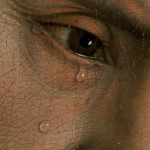O REASON NOT THE NEED!: In an earlier post, I claimed that aesthetic judgments could not be derived from reason: “There are good but non-rational reasons for believing things. (I take ‘irrational’ to mean ‘anti-rational, contrary to reason,’ and ‘non-rational’ to mean ‘not using the processes of syllogistic reasoning but not contrary to such reasoning.’) ‘Non-rational reasons’ may sound like an oxymoron, but let’s take a look at one important example: aesthetic judgments. What process of syllogistic reasoning can lead us to conclude that Hamlet is a greater work of art than The Long Goodbye, or that Goodbye is nonetheless a terrific book? Beauty and sublimity are encounters, not conclusions of philosophic reasoning (although the conclusions we draw from reasoning may make it easier or harder for us to see or accept beauty or sublimity in certain places–for example, I’m not sure I could have found El Greco’s ‘Saint Sebastian’ sublime rather than horrible before my conversion; I was very anti-depictions of Saint Sebastian in general).”
My more Randian readers will take issue with this, of course. Let me make my case via three oblique routes: a query, a note, and a challenge.
Query: Part of the difficulty in discussing the “non-rational” is that I’m not entirely clear on how Objectivists understand the rational. Rand tries to derive rationality from human needs for happiness and for survival–“if you live by faith instead of reason you can’t survive,” that sort of thing.
I think the attempt to base Objectivist-reason on happiness falls apart in your hands, since Objectivists generally want to hold on to a notion of “rational happiness” or the happiness of a rational man. Thus even if contemplative prayer, or lots and lots of marijuana, makes you happy, you should eschew it because your happiness is not rational.
Trying to derive an understanding of reason from the need for survival is somewhat stabler, but still a bit odd since it’s not clear to me that, say, atheists survive better; and since most Objectivists want to acknowledge that there are times when it is acceptable to either a) commit suicide or b) sacrifice your life for, say, freedom. Thus there are rational anti-survival acts. (This is where Rand’s concept of a “living death” comes in–I think the Chickpea Eater addressed that pretty well at the end of this post.) So I keep wondering whether Reason is in fact not derived from either happiness or survival (or some balancing of both).
If it is a third thing, rather than merely Whatever Makes You Happy or Whatever Makes You Last or Whatever Makes You Last Unless It Makes You Really Really Unhappy, then Objectivism runs into the Platonic-forms problem I outline here and in the two posts that follow.
So the first thing to get clear is that I am not entirely clear on what, for an Objectivist, would constitute a rational approach to aesthetics. I know where it ends up–that’s the subject of the dissection, below–but not how it gets there. What is the reason that discerns aesthetics? Whence is it derived? Perhaps an explanation of that question will make the challenge irrelevant (though for now I doubt that).
Note: I spoke of the beautiful and the sublime as “encounters” above because I wanted to emphasize how unexpected they are. We can create beautiful and sublime things, but we can’t predict in advance what we will recognize as beautiful or sublime. Each experience of beauty or sublimity adds to the store of experiences that we draw on when we’re trying to figure out what beauty and sublimity are. Thus I would reject any theory of aesthetics that concluded that Hamlet is not great art; my startling and awe-inspiring encounter with the play is prior to my aesthetic theory. As I said above, when your worldview changes you may be able to see beauty where you missed it before (I think it is even more likely that you will see sublimity where you once saw only horror, but probably beauty can be illuminated by reason as well), and worldview shifts can also make you see flaws in art that you once considered near perfection. (I’m speaking only of the beauty of art, here, rather than the beauty of humans or objects; you can get my thoughts on those other kinds of beauty here.) This unpredictability is the basis of my claim that aesthetics cannot be derived solely from rationality; beauty enters from outside, and shapes aesthetics around itself. This does not mean that aesthetics is irrational–see above.
Challenge: No matter how an Objectivist account of how to derive aesthetics from rationality gets off the ground, it generally winds up by saying that great art expresses the values proper to a rational being. Great art provides inspiring heroes and states true things about the world. It expresses a belief in reason alone, in man as self-made soul, in human potential, in the evil of faith and mooching and the goodness of work and perseverance. Great art is news you can use. Great art has the virtues of The Fountainhead.
Works that are not great art, under this definition: King Lear (two of the many non-Objectivist underlying assumptions of this play: the world is broken and unfixable; God is a crooked dealer, not a cruel fiction), Hamlet (among other things: man achieves transcendence through submission to fate), “Aubade” (mortality is cause for despair), Sabbath’s Theater (see King Lear), The Brothers Karamazov (among many other things, atheism causes collapse into the self, whereas acceptance of Christ’s sacrifice leads to peace and charity), Waiting for Godot (reason is merely the set-up for a living joke) and Endgame (see Lear), the Iliad (crush your enemies, see them driven before you, and hear the lamentations of their veemen), the Odyssey (yay deception!), the poetry of Emily Dickinson (too many things to mention), the fairy tales of Oscar Wilde (love is self-sacrificial charity)… and many many more family favorites.
Is that a bug in the system?
The non-Objectivist underlying assumptions of these works are not merely subplots or side dishes; they’re the main course. They’re integral to the works. Are we to believe that in the rational future, these works will be surpassed by works exalting happiness and denigrating self-sacrifice? Will we then study Hamlet as we now study The Spanish Tragedy, interested only in its influence on later works? Will we discard these works, leave them to the historians of literature rather than the seekers of truth and beauty? Will they be labeled What Not To Do, caged and displayed as perfect examples of the ways irrationality perverts genius?
I believe that some of these works (Lear for example) speak with double tongue. They are true, in that they present a real way that real humans have responded to our real world. They are distilled–there’s that word again–expressions of a Gnostic world, a mortal world, a world of pride. (They are far more honest than The Fountainhead.) But they are also false, since they show the real world filtered through a false lens. They show how mortality looks without immortality, for example; I agree with the description but deny the premise that immortality does not exist.
I have no problem with this complexity. Lear does not express my values, and I won’t try to madly cram a right-hand foot into a left-hand shoe. (For a while I tried to argue that Hamlet is ultimately a Christian play, but that’s just not true. It is at most a play seesawing wildly between Catholicism and amor fati.) Lear presents a way of being–an allegory, if you like. A thisness or essence. (Argh, I’m fluttering off into Stephen-Fry-talks-about-love-land. Let’s haul ourselves back to the shoals of sense, shall we?)
My challenge, then, is: What is the (or an) Objectivist response to works of art that express values contrary to Objectivism? Is there anything to say to Shakespeare except, “You’ll be the first against the wall when the revolution comes, boyo”? And if these anti-Objectivist-rationality works are to be saved, how is an Objectivist aesthetics derived from reason alone?











